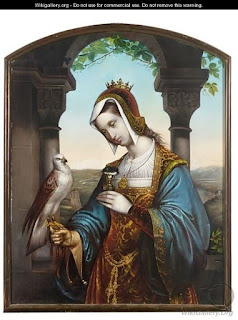Clearly now, I can tell the sewing on the face is wrong but crucially am able to understand why: the stitches do not stack up in the correct order of one row to the left, return row pointing to the right. So because the rows did not form pairs in this way, the stitches did not stack up as I know now that they should. I will leave the face alone however, but just re-do the forehead. because that will be do-able.
The piece is going to be made up by various slips, which will then be mounted together to form the image below, again it’s smaller than A4. I’ve decided to work in that way because that’s what can be seen on extant pieces, especially if you look at them from the side of the display case in museums.
I was thinking quite a bit of my DD at the time of sewing this image and as a result it looks more like her than the medieval lady. Two serious ladies with great hair...
I’m very interested in the pattern on her clothes now, I wonder how faithfully they can be reproduced. I might try a little swatch and see how it goes. The question is always the same: do we simplify what we see or do we use the complexity of such a pattern as a springboard for creativity? We’ll see...
I stopped working on it back then, because I realised the folds of her drapery were going to be really (really ) hard. Now I shall tackle them with underside couching of silk thread, which I’ve seen used on period pieces very effectively to describe drapery of clothes. It’s a great design for running away with the illusion of texture...
I’ll post some museum examples next time...
It’s finally raining in Blighty again to cool us all off after being so incredibly hot for days and nights on end.























Glad things are cooler. I stitch better in cooler weather.
ReplyDelete